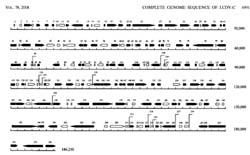

A research group headed by Prof. Zhang Qiya from the CAS Institute of Hydrobiology has succeeded in sequencing the complete genome of lymphocystis disease virus isolated from China (LCDV-C), a virus isolated from cultured flounder (Paralichthys olivaceus) with lymphocystis disease in China. Their work has been published in the recent issue of Journal of Virology (2004, 78 (13): 6982-6994).
Lymphocystis disease is a chronic virus disease affecting more than 120 species of teleosts worldwide. Freshwater and marine fish are susceptible to this virus. It causes crusty deposits of malformed cells to develop on the skin and fins of a wide range of fish and has no known cure. As the largest marine-culture country in the world, China's fishery is increasingly affected by the disease.
Although being documented as early as in 1874, it was not until 1962 that the disease was found to be caused by LCDV. European laboratories have started the molecular studies of the virus since the 1980s, and the first complete genome sequence of the virus (LCDV-1) was made in 1997 by two Germany researchers.
In comparing the genome of LCDV-C with that of LCDV-1, the researchers have found unexpected levels of divergence between them in size, gene organization, and gene product identity. They suggested that they shouldn't belong to the same species and that LCDV-C should be considered a species different from LCDV-1. Their analysis showed that there are in fact several different species of viruses, and a phylogenetic tree for the group has been proposed.
The work on LCDV-C will not only lay a solid foundation for developing vaccines against the disease but also provide important information for revealing the pathogenic mechanism of various kinds of lymphocystis viruses across the world, said Prof. Gui Jianfang, an author of the paper and IHB Director.

86-10-68597521 (day)
86-10-68597289 (night)

86-10-68511095 (day)
86-10-68512458 (night)

cas_en@cas.cn

52 Sanlihe Rd., Xicheng District,
Beijing, China (100864)

